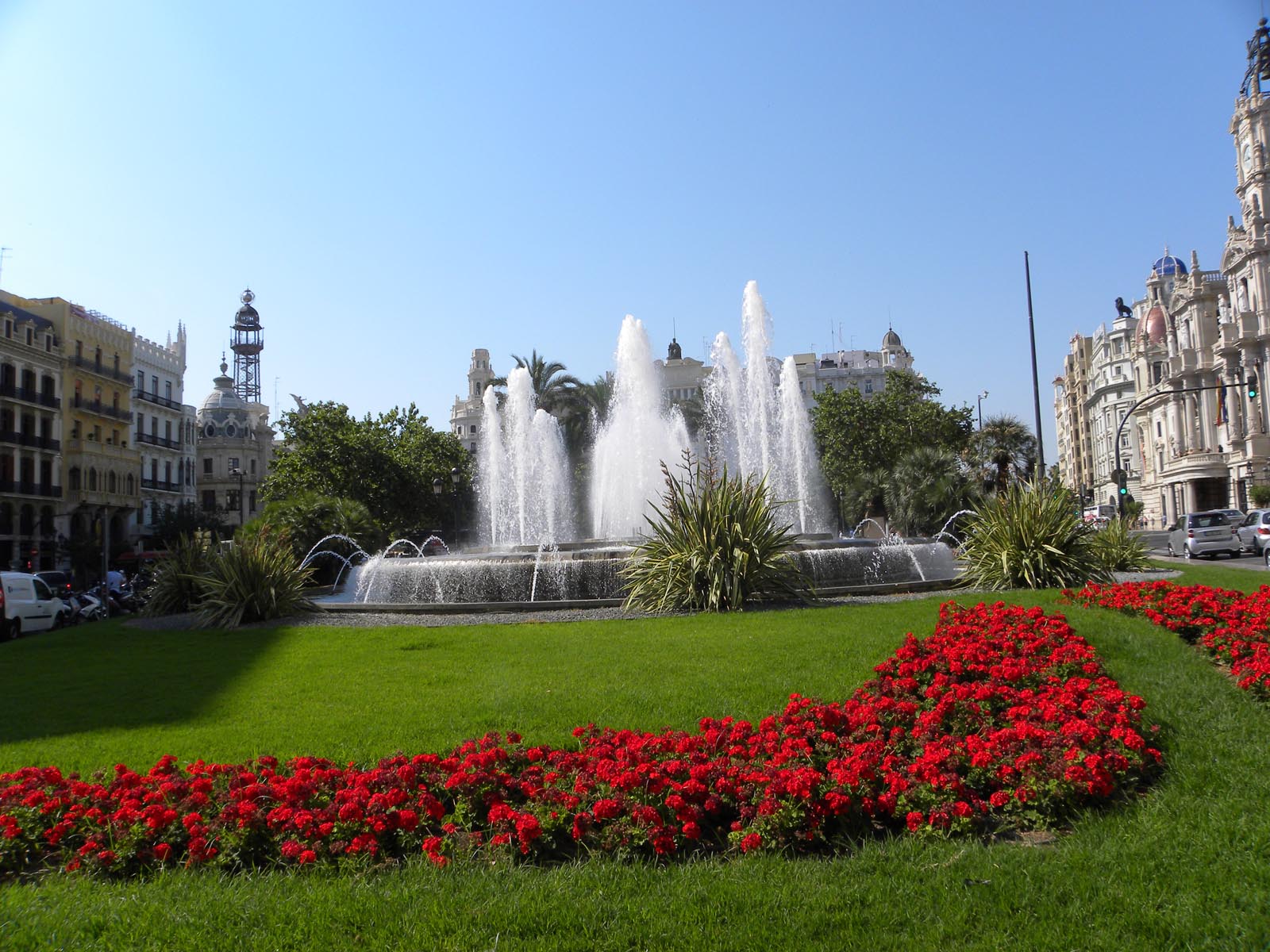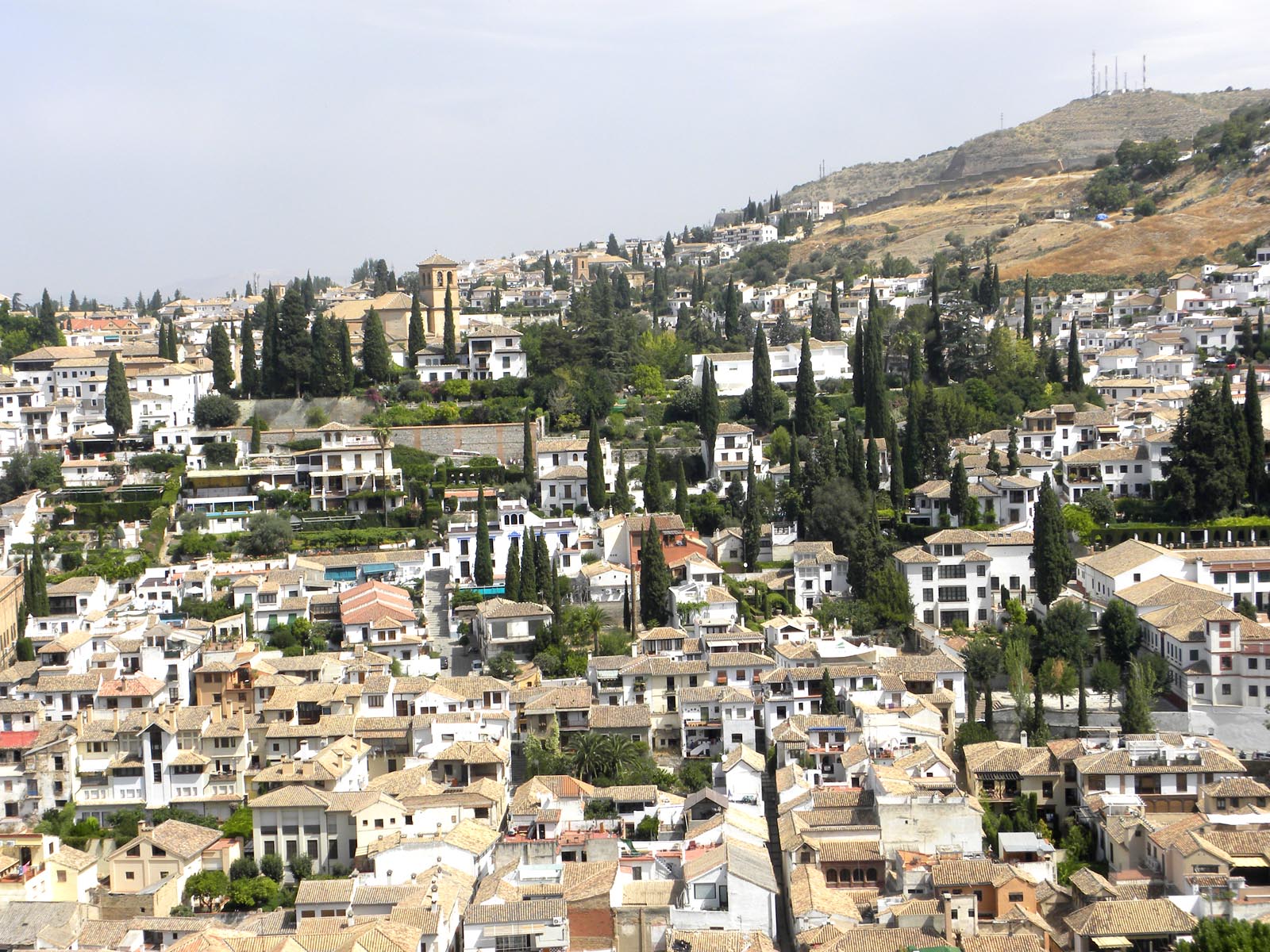
By contrast to most tours, we went on our own to Spain and chose not to spend time in the largest cities of Madrid and Barcelona but to tour the historic sites of fabled ancient cities of Toledo, Granada, and Valencia. In Valencia we got our first and excellent impressions of Spain. We walked the main streets of this beautiful city of trees and flowers and gorgeous elaborate 19th century architecture on main plazas. Ornate fountains and statues, some marble sidewalks, make up the shopping and government plazas. We saw thousands of large, well-kept apartment buildings, but we saw no free standing houses in the Center of the city. Our Spanish came back quickly and we were reading signs without translating. Our Mexican Spanish vocabulary differed a bit from that of SpaIn, but everyone we spoke with seemed to understand English and speak it well enough for the needs of tourists.
We walked to the impressive Valencia Cathedral where we discovered the Red Bus Valencia Turistico,  the hop on/off bus. Since the tickets last 24 hours we boarded the last bus for the blue line, which goes to the Mediterranean Seaport and the ultra-modern complex Oceanographic and the City of Arts and Sciences and seven other stops at amazing places outside Valencia’s Center. This 90 minute tour with excellent audio commentary (by earphones with many different languages) was a great overview of that part of city in cool breeze of top floor, open air part of the bus. Since early 1900’s Valencia has grown out to incorporate the former agriculture/fishing villages, which now consist of excellent apartment buildings and modern commerce centers. This is still the first and main port of trade in Europe.
the hop on/off bus. Since the tickets last 24 hours we boarded the last bus for the blue line, which goes to the Mediterranean Seaport and the ultra-modern complex Oceanographic and the City of Arts and Sciences and seven other stops at amazing places outside Valencia’s Center. This 90 minute tour with excellent audio commentary (by earphones with many different languages) was a great overview of that part of city in cool breeze of top floor, open air part of the bus. Since early 1900’s Valencia has grown out to incorporate the former agriculture/fishing villages, which now consist of excellent apartment buildings and modern commerce centers. This is still the first and main port of trade in Europe.
In Spanish summers it is daylight until after nine p.m., and the restaurants open around 8 p.m. Because Siesta is still observed from 4 – 6 p.m. in most places it is difficult to have lunch after 2 p.m. or to have dinner before 8 p.m.
Anyone who visits Valencia must try Paella, which is a mixture of fruits of the sea served over rice. This international favorite dish was invented in Valencia and has many variations. The fresh seafood was probably harvested today at the port nearby. By American standards restaurant prices in Spain are a good value and most prices from restaurant to restaurant seemed comparable in the popular streets that featured inside or outside dining for the hundreds of establishments.
The next morning we returned with our Red Bus tickets and earphones about 11 a.m. for Historical Tour on their red line for the totally different route than the blue line. Seeing the important places steeped in history through the centuries and learning about each via the excellent narration is the perfect way to get to view the impressive plazas, many unique bridges, gorgeous arboretums and parks of the city on the comfortable double-decker bus, air conditioned below and open air above. The River Turia was rerouted to South of the city crossing East to West after a huge, devastating flood of 1957 and many other floods before that. Now the bridges cross a lovely park of trees & flowers and play areas extending many kilometers through main city thoroughfare. Families enjoy the midway with Ferris wheel and rides and other attractions, all in the now dry riverbed. The River had many viaducts, built by the Romans and 500 years of Muslim rulers, to send water to the agriculture areas. Early 20th Century industrial age architects redesigned Valencia to look like Paris with trees and flowers and wide, straight, planned streets, which can even handle today’s traffic efficiently.
At Huerta do Santa Catalina in a little restaurant beside the oldest monastery tower, we discovered delicious horchatas, which are sweet frosty drinks like a milkshake made with local almond milk. And fresh squeezed from Valencia Oranges is the perfect orange juice! Then we got back on the bus for the blue line route to the fabulous, ultra-modern Arts and Science Center, designed by Architect Jimenez Deredea, to see the current exhibit which was a Pixar Exhibit celebrating 25 years of computer generated films. The permanent exhibits in this huge, modern complex is informative and everyone has fun learning in hands-on explorations of science and art.
We hopped on the bus again to prevent the long walk to Oceanografic, the largest Aquarium in Spain with nine different buildings in which we viewed thousands of sea creatures and fish from different oceans of the world: tropical, temperate, and icy waters. We marveled at fish, crustaceans, beluga whales and walrus.
We walked through the wonderful aviary of birds that inhabit wetlands. This was a wonderful but exhausting afternoon with miles of walking through indoor and outdoor exhibits and one building where we went through an enormous glass tunnel with fish over and around us. Explanations in pics in several languages including English taught us so much and gave such incredible memories. This is well worth the ticket price. By the time we caught the last bus back we were very tired and ready for the narrated ride to see more of the beautiful city of Valencia.
About the Author:
Bonnie Neely, a professional journalist for over 30 years, has worked extensively in educational television in which she has been project coordinator, researcher, and scriptwriter. She has also been a columnist for various newspapers and magazines as well as a producer/scriptwriter for the Discovery Channel. Furthermore Bonnie is one of the “Top Book Reviewers” for Amazon.com. She founded Real Travel Adventures and built it into a leading travel blog.







